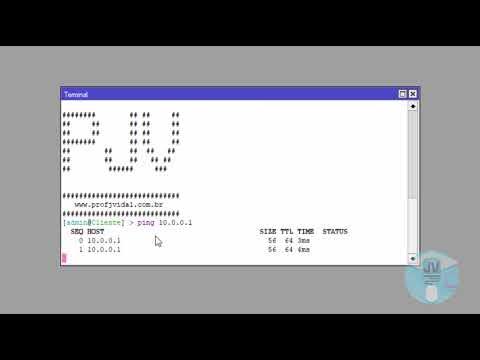Static Routing Overview & Configuration
Summary
TLDRThis video explains the concept of static routing in networking, focusing on how to manually configure routes on a router using the `ip route` command. It covers best practices for static routes, such as using a next-hop IP instead of a local interface to avoid performance issues like ARP traffic. The video also demonstrates troubleshooting techniques, such as verifying connectivity through ping tests and inspecting routing and ARP tables. The overall goal is to teach network administrators how to effectively manage routing in their network environment.
Takeaways
- 😀 A static route is a manually configured network route that defines a subnet or entire network class (A, B, or C).
- 😀 Static routes can specify either a next hop IP or an outgoing interface to direct traffic.
- 😀 The correct syntax for configuring a static route on a router is 'ip route [network] [subnet mask] [next hop IP]'.
- 😀 Specifying a next hop IP in static routes is considered best practice over specifying a local interface, to avoid broadcast issues.
- 😀 Using an Ethernet interface for static routes can cause unnecessary ARP requests and network broadcasts, which is inefficient.
- 😀 If a router’s interface associated with a static route fails, the static route is automatically removed from the routing table.
- 😀 CLI commands like 'show ip route' and 'show ip interface brief' help verify the routing table and interface status.
- 😀 Directly connected routes (C) appear in the routing table and are preferred over static routes (S), which are manually configured.
- 😀 A host route (with a /32 subnet) is automatically inserted for any specific IP address configured on an interface.
- 😀 Static routes can be manually added to enable routing to networks that are not directly connected, such as 'ip route 192.168.0.0 255.255.255.0 10.0.0.2'.
- 😀 Specifying a local interface in a static route, rather than a next hop IP, can lead to performance issues due to large ARP tables and broadcast traffic.
Q & A
What is a static route in networking?
-A static route is a manually configured network route that defines a specific subnet or class (A, B, C) and specifies either an outgoing interface or a next-hop IP address for routing traffic.
How do you configure a static route on a router?
-To configure a static route, you use the command 'ip route', followed by the network address, the subnet mask, and the next-hop IP address (or the outgoing interface).
What is the difference between specifying a next-hop IP address and an outgoing interface in a static route?
-Specifying a next-hop IP address is considered a best practice, as it avoids unnecessary broadcasts and ARP lookups. Using an outgoing interface instead of a next-hop IP may lead to performance issues, especially on non-point-to-point links.
What does the 'S' flag indicate in the router's routing table?
-The 'S' flag in the routing table stands for a static route, meaning the route was manually entered by the network administrator.
Why is it not recommended to specify an outgoing Ethernet interface in static routing?
-It's not recommended because Ethernet segments involve multiple devices, which can result in broadcasts to all devices on the network, increasing overhead and potentially leading to network performance issues.
What is the 'C' flag in the routing table, and what does it indicate?
-The 'C' flag stands for a connected route. It indicates that the network is directly connected to the router's interface, without the need for routing through another device.
What is a host route and how does it appear in the routing table?
-A host route is a route with a /32 subnet mask, representing a specific device rather than a network. It is automatically inserted into the routing table for interfaces with an IP address.
What happens if a router interface associated with a static route fails?
-If the router interface associated with a static route fails, the router automatically removes the static route from its routing table, ensuring that traffic isn't sent to a non-functional path.
What is the impact of using a static route with an interface instead of a next-hop IP on non-point-to-point links?
-Using a static route with an interface instead of a next-hop IP on non-point-to-point links can lead to performance issues, including excessive ARP requests and network broadcasts, which may impact the overall performance.
How does the 'show ip route' command help in troubleshooting static routes?
-The 'show ip route' command displays the routing table, allowing you to verify whether static routes are configured correctly and if they are being recognized by the router, along with their administrative distance and status.
Outlines

Cette section est réservée aux utilisateurs payants. Améliorez votre compte pour accéder à cette section.
Améliorer maintenantMindmap

Cette section est réservée aux utilisateurs payants. Améliorez votre compte pour accéder à cette section.
Améliorer maintenantKeywords

Cette section est réservée aux utilisateurs payants. Améliorez votre compte pour accéder à cette section.
Améliorer maintenantHighlights

Cette section est réservée aux utilisateurs payants. Améliorez votre compte pour accéder à cette section.
Améliorer maintenantTranscripts

Cette section est réservée aux utilisateurs payants. Améliorez votre compte pour accéder à cette section.
Améliorer maintenantVoir Plus de Vidéos Connexes

Static Routing Using 3 Networks | Cisco Packet Tracer | Networking

Konfigurasi Routing Statis Mikrotik

Static Routing - CompTIA Network+ N10-009 - 2.1

Configurações Básicas - Mikrotik RouterOS - P1

Everything Routers do - Part 1 - Networking Fundamentals - Lesson 5

How to configure Dynamic Routing | Dynamic Routing configuration step by step
5.0 / 5 (0 votes)
